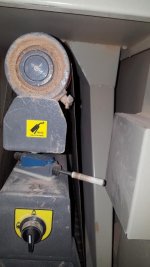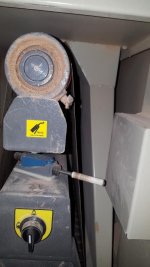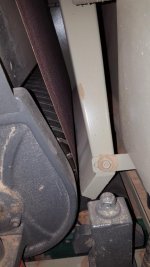My situation: I have a 3-car garage, and my power tools are in two bays of that garage. I am currently using a 2 HP Laguna Cyclone, but I'm getting ready to upgrade to a ClearVue 1800 with the 16" impeller upgrade. (I'm waiting for the next sale.) I have 6" mains. While preparing for the cyclone upgrade, I'm doing an inventory of tweaks to my tools so that I can get the most of out of the upgrade.
One of the tools I'm concerned about is a Grizzly wide belt sander (G0527). Unfortunately, my shop layout dictates that this tool sit far enough away from the Cyclone that there's about 20' of ductwork and one gradual 90 (made from two 45 elbows) to the drop. I then have a wye with a 4" connector for the drop to the Grizzly. Unfortunately, Grizzly put a single 4" dust port on the outside of the machine. Although I would like to upgrade this to a 6" port, Grizzly also welded an assembly inside the machine that takes this port and funnels it to the location where the dust should be coming off the belt. On the one hand, I think it's great that they are trying to funnel the airflow to the precise source of the dust. But on the other hand, limiting the system to a 4" port really sucks. Bill Pentz's calculator shows a 4" tapered port results in a 3.14 SP drop! Ouch! By the time I add 18" of 4" flex to connect this to the wye off my main run (another 2.34"), and by the time I throw in 20' of 6" ducting and a couple gradual bends, with 1.5' of 6" flex to connect the cyclone to the mains, I'm over 13" SP. Unfortunately, moving the machine or the dust collector is not an option. I would hate to have to upgrade all my mains from 6" to 7". Any other suggestions? Will the 1800 draw enough air through this setup to keep me up near the 1000 CFM I would love to get?
Pictures
Here is the 4" dust port:

Here is the funnel inside the machine that goes from the 4" dust port at the top down to a sort of "sweep" where the belt is doing its work:
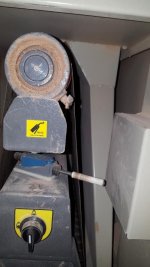
A better picture of the sweep at the bottom of the belt:
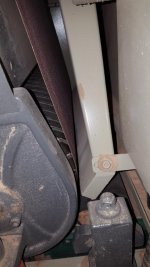
One of the tools I'm concerned about is a Grizzly wide belt sander (G0527). Unfortunately, my shop layout dictates that this tool sit far enough away from the Cyclone that there's about 20' of ductwork and one gradual 90 (made from two 45 elbows) to the drop. I then have a wye with a 4" connector for the drop to the Grizzly. Unfortunately, Grizzly put a single 4" dust port on the outside of the machine. Although I would like to upgrade this to a 6" port, Grizzly also welded an assembly inside the machine that takes this port and funnels it to the location where the dust should be coming off the belt. On the one hand, I think it's great that they are trying to funnel the airflow to the precise source of the dust. But on the other hand, limiting the system to a 4" port really sucks. Bill Pentz's calculator shows a 4" tapered port results in a 3.14 SP drop! Ouch! By the time I add 18" of 4" flex to connect this to the wye off my main run (another 2.34"), and by the time I throw in 20' of 6" ducting and a couple gradual bends, with 1.5' of 6" flex to connect the cyclone to the mains, I'm over 13" SP. Unfortunately, moving the machine or the dust collector is not an option. I would hate to have to upgrade all my mains from 6" to 7". Any other suggestions? Will the 1800 draw enough air through this setup to keep me up near the 1000 CFM I would love to get?
Pictures
Here is the 4" dust port:

Here is the funnel inside the machine that goes from the 4" dust port at the top down to a sort of "sweep" where the belt is doing its work:

A better picture of the sweep at the bottom of the belt:

Attachments
Last edited by a moderator:

